Genoa, after the closure of the Museum of Villa Croce, excluding the formalized spaces of the galleries, certainly needed a revolution and aesthetic innovation or simply of Contemporary Art. Then comes a project that renews the static air that was perceived in the city and to think about it was Francesco Arena, curator and creator of “ OTHER IDENTITY-Altre forme di identità culturali e pubbliche “.
International event of contemporary art that embodies photographs, installations, video art, performances and electronic music, where the concept of identity is expanded beyond the figure of self-representation, up to precisely “other forms of cultural and public identity”.
The project was conceived as a transposition of the identity of the curator himself on the works he selected, the artists and the selected venues. For the second edition, Other Identity returns to 4 locations, 3 of the most important galleries in Genova: ABC-ARTE Gallery, Guidi&Schoen-arte contemporanea Gallery, PRIMO PIANO di Palazzo Grillo, and one of the most dynamic official spaces in Genoa, Sala Dogana-Palazzo Ducale.
As the curator states in the event catalog:
“An edition that presents itself as “unplugged” after the first release in a huge venue that is the one of the Loggia della Mercanzia always in Genoa; “music for the eyes” where works of art and visual and audio projects intends to show the existing contamination between visual and performing arts, and the indissoluble bond created with contemporary music.”
Each location has several peculiarities in it and in it the choice of Francesco Arena to favor the invited artists by contrast and assonance.
At the vernissage of Other Identity several performances alternated, among these, at the Guidi&Schoen gallery, that of Nadia Frasson entitled “Noli me tangere“, where the artist previously sewed on skin-colored pink organza, the shape of a brain and during the three-hour arch has embroidered over small black ants; ants are insects that creep in excellence and represent a penance for the artist, a torture on their own skin and memory. After the performance Nadia‘s organza remains as a relic inside the gallery and more than a post-performance installation, we could define it as a trace of “what it was”.
At the ABC-ARTE gallery instead the performance of Cinzia Ceccarelli with Mihaela Slav entitled “Tso (treat me without oblivion)” denounces the wrong system of the world of psychiatry, about what should be the compulsory care provided by that branch of science.
In Sala Dogana at Palazzo Ducale, the Skin/Tones performance by Francesca Fini, sees the artist undress from a delicate bathrobe and sit on a white cube where he begins to analyze parts of his body through a digital microscope; traces of skin, hair, eyes, hair and saliva, are transposed on the projector in front of her and the user, inviting the latter to accept the mapping of her body. The visitor becomes voyeur, he no longer observes the body of the artist but his macroscopic and deformed elaboration, a sort of “super-selfie“, as she herself defines, transmitted through a filter, an invisible membrane.
Also in Sala Dogana at the end of the evening the FLeUR (Enrico Dutto and Francesco Lurgo) performed live electronic music, where the soundscape blends with the digital world, and where post-rock joins an obscure ritual.
As in a tour in Genoa we find ourselves living the art in all its facets, starting from PRIMO PIANO di Palazzo Grillo, historical building of Genoa, where we see installed and shown almost small personal. Each room contains the artist’s intimate story, I would call it a “diary of images”, where the concept of memory and current events alternate and where the contemporary nature of the works displayed fits perfectly with the historicity of the location.
Entering we find the works of Debora Garritani, where symbols and iconographic references with a Flemish taste intersect with contemporary elements, here the artist denounces the appearance at the expense of being; in the second room the artist Romolo Giulio Milito with 12 diptychs, brings us into a much more intimate and personal atmosphere, for him eroticism is the exact encounter between himself and his models, in the same room the artist wanted to insert a personal catalog where the visitor can intervene in pen with words and drawings, on the white of the pages or on the images themselves, so that the catalog becomes “unique” as the work of art. This location has very high but welcoming rooms, as are the landscapes, the scenes, the sharp contrasts between Giorgio Galimberti’s black and white; his characters get lost and mix with the surrounding environment, here the identity of man becomes one with that of the places that host him; in the central hall we find Alexi Paladino (Lilian Capuzzimato) with a photographic reproduction of his collages, a personal diary where the concept of identity is seen through traces of his past and the characters of a true story are in constant conflict with each other; here, despite the bitter taste of the stories, there is always a declaration of love for his family; in the same room, by contrast, Montserrat Diaz throws us into a reality where apparently everything is in balance, its self-portraits are infected by the concept of space and time and the image appears “clean” and “built”. Continuing in these rooms, in the project we also find the large vinyl paintings of Ivan Cazzola, tall, powerful, here the contemporaneity of his shots related to the world of fashion, music and entertainment, contrasts with the frescoes on the vaults.
The last room hosts two artists, Monica Mura and Donatella Izzo, the first shows her installation, a large silk curtain depicting her face split into two parts, one obvious and the other pixelated (almost wanting to present deteriorated, low resolution); the resolution, in computer science and in graphic design is the magnitude that indicates the degree of sharpness or clarity of an image, in this case the pixel is the ability of the image to recover its initial state and is indeed enriched with colored interventions in gold, just to want to highlight the importance and the preciousness of its “hidden” part at the expense of its obvious part; the curtain is combined with a looped video that takes up his own face in a continuous metamorphosis between outlined shapes and pixellature; the second artist Donatella Izzo presents installations with everyday objects (such as a table and a 1980s pouf) in dialogue with photographic portraits, or rather as she calls them “anti-portraits”; in his works, sacredness and history merge and spiritual identity is opposed to the supernatural silence.
PRIMO PIANO di Palazzo Grillo for its structural peculiarities is exactly the historical container par excellence that serves to match and enhance in the best way, the path of the artists chosen for this venue.
Among the project’s locations, two of the most important Genoese galleries emerge; ABC-ARTE and Guidi& Schoen-Arte contemporanea.
The Guidi&Schoen gallery does not follow a specific line or media, but rather follows what is profoundly meaningful and formally sophisticated, and this has also been transported by the curator within the space.
In the first room the photographs of Nadia Frasson with hand-embroidered interventions, perfectly match the works of the German Sebastian Klug who works on the weaving of two photographic prints, here the contemporary flavor is linked to craftsmanship and identity is seen as concept of “dissolution”.
Walking through the gallery, the female bodies linked to the landscapes of Marco Cappella alternate with those of the couple of ERRESULLALUNA+ChuliPaquin, where “the image is a step, and the step becomes dance”, here the most banal gesture becomes intense; while in the same room also appears the great diptych with dark colors by Ramona Zordini, a dialogue on full and empty spaces that can be summed up perfectly in a quote by Jean Paul Sartre “only, this identity of essence is not accompanied by an identity of existence”.
The project expands into several rooms and we discover the work of Patricia Eichert, where the juxtaposition of her presence (at least in part, given that she only photographs her legs) in domestic settings accompanied by her dogs, give the project irony and sarcasm, so as to contrast the most introspective works of Christina Heurig, which instead highlights a real “contemplation of one’s own disorders”, as the artist herself defines.
Among the artists also Karin Andersen and her surreal characters, here the identity is often seen as a mixture between the human and the animal, while the place is a real ecosystem where it is possible to live and adapt with its own changing genetics.
The contrasts so loved by the curator are also evident in the style of the individual artists; where we are usually used to seeing the large and immense artificial landscapes of Giacomo Costa, for Other Identity the artist expresses himself through his ironic and unpublished self-portraits and in this case he denounces the social stereotypes, he does it through the disguise of himself and the another seen by itself.
We dwell on the penetrating characters of Richard Kern, with the strong white blacks, where the key point is this: “..to the spectator’s voyeurism always corresponds the exhibitionism of the represented”.
The upper part of the gallery is structured like many white cubes, while the lower part, the “basement” has rooms with exposed walls, where the industrial atmosphere is much darker and mysterious; hence the choice to include artists who talk about “memory”, in the case of backlit suitcases by Roberta Toscano, or of “brazen intimacy” in the works of Marcel Swann, presented with old recovery frames that fit perfectly to a wall of old clay bricks. Still in the basement, instead, the works of Ophelia Queen and Sandra Lazzarini are linked respectively to social and cultural stereotypes and to the transposition of still life composed of the staging of one’s daily life.
The contest was linked to a project, organized by Radio Babboleo, where for the occasion everyone could send their own self-portrait; at the end of the competition, the best self portrait was shown in the Guidi&Schoen gallery. The winner was the photograph of Isabella Quaranta.
We move from ABC-ARTE, this gallery prefers painting and abstraction where the gestural cut dominates; but for the first time it welcomes a project where the privileged medium is the photographic and performative medium, and gives carte blanche to the curator who has set and set up very different artists in these large white rooms.In entrance we find the works of Manuel Bravi, here “In Deep Red” tells us “the representation of the erotic impulses present in each of us, the marked exhibitionism of the digital times that clashes with the fears of the judgments of others”; Light Painting, a traditional and artisan technique, is well combined here with a strong contemporary impact.
The same room hosts the majestic but delicate work of Davide D’Elia, entitled Adriana, the name of a woman who really existed, where 15 canvases come together to give life to an identity that is represented this time through the concept of absence and memory; in the same environment the diptych of Paula Sunday instead is exactly opposite to the absence and appears in a double identity: she herself dressed as a bride and groom, where to marry oneself means to celebrate one’s independence, a sacred commitment in front of one’s responsibilities.
In the central hall we find the large installations of Bärbel Reinhard and Nadja Ellinger, both represent themselves in dialogue with the natural landscape, specifically the second artist is self-represented immersed in the woods or with natural elements and always does so in a very raw way, combining everyday objects, such as knives or pomegranate juice, a metaphor for blood; use photography to visualize his inner feelings and fears.
From the same theme also the work of Amalia de Bernardis entitled “Natura morta con errore”, where the error is given both by the image of herself represented as a subject subtracted from her own natural environment, and by the compositional choice of the still life to the constant search for precarious balance; as well as from the images, also from the broken frames that enclose his works.
The work of Federica Gonnelli instead consists of 9 tiles, the faces of Louise and Herbert, printed in small organza canvases superimposed between them, are the protagonists that add up to each other, where one cannot do less than the other, where the identity is unique and no longer two.
Natascia Rocchi with her series, works on the photographic reproduction of collages, the historical characters are tied to contemporary ones, almost wanting to erase the years that separated them; the identity here too blends, erasing time.
In front of this wall we find the work of Silvia Celeste Calcagno, the ceramic photography becomes imposing, where we are usually used to seeing it in small format, here the representation of the self becomes immense; beside the triptych by Corinna Holthusen, pictorial interventions on photographic bases reported on canvas of female portraits, where past, present and future merge into a single work, a process of birth, life and death that is repeated in the cycle.
A long corridor welcomes Mauro Vignando, his work on double postcards, tells the journey of film stars (couples of lovers and portraits) on which he then intervenes with cuts, in this case the concept of subtraction of the subject is linked to the subtraction of identity; to follow we find the large-format posters by Francesca Randi, entitled “I Senza Nome“, characters immersed in a dark and nocturnal setting, where the mask becomes on the faces of the subjects, hiding of the self.
To alternate the gaze of the observer we find a more pornographic portraiture with the 35 polaroids by Alessandra Pace and Fausto Serafini, a diary of images, an emotional and sentimental path, where the artists themselves affirm: “We believe that hiding is the most serious error possible , we must expose ourselves, with all the force of truth … “; in front of the triptych by Carmen Palermo, polaroids re-photographed with a voyeuristic taste.
In the textile installation by Isobel Blank, composed of elements in wool, foam, remains of cloth that are compared with small drawings on canvas and a self-portrait of the artist, identity is redefined over time, like the moment suspended in limbo; Boris Duhm presents photographs and writings autographed in gold, in these works the artist stages the concept of “alter ego” and shows the playful confrontation with the power of disguise.
The works by Maurizio Cesarini from the substantial conceptual line close the room, where despite the double presence of the photographed subject (himself and the other seen by himself) the artist manifests himself as “absent”; Emanuele Dello Strologo with black-and-white shots, tells a story in Bosnia; identity is seen as a request for help through the eyes of the protagonist children in these hyper-realistic shots.
At Palazzo Ducale in Sala Dogana, in addition to exhibiting wall works, we find a focus on video reviews. This is the privileged medium here; in fact the spectator is immediately welcomed by thetrailer of the exhibition on the big screen and at the end of the corridor we find the installation/performance of Cinzia Ceccarelli, where a monitor that repeats the waves of the sea and a chair in front of the screen, describes exactly the title of the work “The patience of Penelope”; here the expectation of the return of a love can be essential to feel complete with one’s own identity and the compulsive gesture of weaving is re-evoked before undoing waiting to see the arrival of someone or something in the waves of the sea.
In the second room we find the projection of the videos of: Isobel Blank, Maurizio Cesarini, Silvia Celeste Calcagno, Monica Mura, Francesca Leoni, Solidea Ruggiero, Christian Reinster and Tore Manca (Mater-ia). During the whole period of the exhibition, in the Sala Dogana, the video reviews of: Francesca Fini, Francesca Lolli, Phoebe Zeitgeist and the film by Tore Manca (Mater-ia) entitled Bioethic Vision (a research on the concrete image, on the sound and above all on the relationship between the identity of man and nature, against that material selfishness that is afflicting us at this time).
In the last room, that of the columns, we find Chiara Gini with a triptych linked to the primitive man and the loss of self, while Francesca Leoni presents a photographic work of her performance where the link with the place where she performs is highlighted. Silvia Bigi is inspired by her dreamlike and childlike world and by the memory of a flight (that of the bumblebee) among the trees of the home garden; Giacomo Infantino outlines the places of his city, Varese, where human figures often appear immersed in nocturnal and dark scenarios, as if they were part of the same environment; Chiara Cordeschi reveals her identity through details of her body, the essence of femininity is a constant link between her projects.
The electronic music lives of Luca Fucci and The Deep Society (Valerio Visconti and Mirko Grifoni) are proposed at the end of the project, with visuals strongly influenced by contaminations linked to contemporary video art.
Every artist in every venue has been able to show himself without hesitation; it does not exist only to perform and show itself: Other Identity thus becomes a true declaration to the world of multiple cultural and public identities, which often overlap and divide, where the word identity is too often proclaimed, but always too little understood.
Here’s how the curator Francesco Arena speaks in the catalog:
“…artists who by exhibiting their works take a personal challenge and talk about themselves directly and sincerely, with no mediations, through different but honest sensitivities. The colours of the photos, videos and installations blow up, this time, in the austerity and authoritativeness of private spaces, in the elegance of the locations, facing in a clear-headed and energetic way this challenge that for several artists is their first great official trial.”
Benedetta Spagnuolo
26-03-2019
OTHER IDENTITY-Altre forme di identità culturali e pubbliche
Second Edition
curated by Francesco Arena
9 – 23 March 2019 | GENOA
Exhibition extended to March 29th
Free entry
Contemporary art exhibition (Photography – Installations – New Media Art – Videoart – Electronic Music)
With the patronage of the Liguria Region and the Municipality of Genoa
In collaboration with: Goethe-Institut Genua, ABC-ART gallery, Guidi&Schoen-Arte contemporanea gallery
Organization: Benedetta Spagnuolo/ARTISTI ITALIANI-arti visive e promozione
Partners and sponsors: Radiobabboleo, Il Secolo XIX, Locanda di Palazzo Cicala, EdArte-Associazione Culturale, AA Photography by Alessandro Arnò and M. Lucia Menduni, Valentino Visuals, Capra Pictures
Cover photo: Chiara Cordeschi
ABC-ARTE: Via XX Settembre, 11/A
Mart-Sab 09:30-13:30 | 14:30-18:30 Dom e Lun on appointment
Guidi&Schoen-Arte Contemporanea: Piazza dei Garibaldi, 18R
Mart-Sab 10:00-12:30 | 16:00-19:00
PRIMO PIANO di Palazzo Grillo: Vico alla Chiesa delle Vigne, 18R
Merc-Dom 16:00-20:00
Sala Dogana-Palazzo Ducale: Piazza Matteotti
Mart-Dom 16:00-20:00 (fino al 23 Marzo)
Info
otheridentity.project@gmail.com
www.otheridentity.it
www.facebook.com/OTHERIDENTITY.project
+39 340 2540631
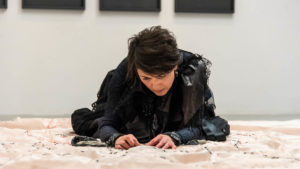 “Noli me tangere”. Performance by Nadia Frasson. Galleria Guidi&Schoen-Arte Contemporanea. Ph. By AA Photography di Alessandro Arnò e M. Lucia Menduni
“Noli me tangere”. Performance by Nadia Frasson. Galleria Guidi&Schoen-Arte Contemporanea. Ph. By AA Photography di Alessandro Arnò e M. Lucia Menduni
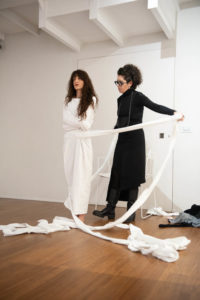 “Tso (trattami senza oblio)”. Performance by Cinzia Ceccarelli con Mihaela Slav. Galleria ABC-ARTE. Ph. By AA Photography di Alessandro Arnò e M. Lucia Menduni
“Tso (trattami senza oblio)”. Performance by Cinzia Ceccarelli con Mihaela Slav. Galleria ABC-ARTE. Ph. By AA Photography di Alessandro Arnò e M. Lucia Menduni
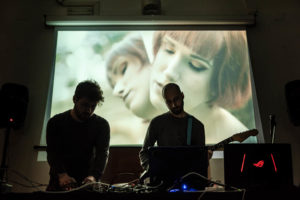 FLeUR (Enrico Dutto-Francesco Lurgo). Electronic Live. Sala Dogana-Palazzo Ducale Ph. By AA Photography di Alessandro Arnò e M. Lucia Menduni
FLeUR (Enrico Dutto-Francesco Lurgo). Electronic Live. Sala Dogana-Palazzo Ducale Ph. By AA Photography di Alessandro Arnò e M. Lucia Menduni
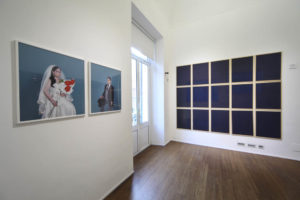 Exhibition view at ABC-ARTE Ph. By Francesco Arena
Exhibition view at ABC-ARTE Ph. By Francesco Arena
 Exhibition view at ABC-ARTE Ph. By Francesco Arena
Exhibition view at ABC-ARTE Ph. By Francesco Arena
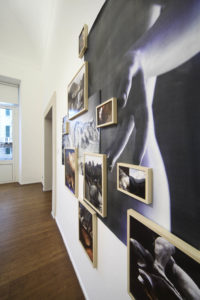 Artwork by Bärbel Reinhard. ABC-ARTE Ph. By Francesco Arena
Artwork by Bärbel Reinhard. ABC-ARTE Ph. By Francesco Arena
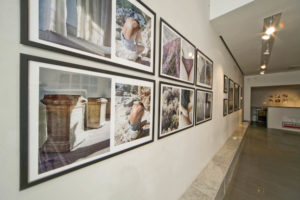 Exhibition view at Guidi&Schoen-Arte Contemporanea Ph. By Francesco Arena
Exhibition view at Guidi&Schoen-Arte Contemporanea Ph. By Francesco Arena
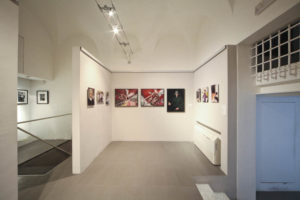 Exhibition view at Guidi&Schoen-Arte Contemporanea Ph. By Francesco Arena
Exhibition view at Guidi&Schoen-Arte Contemporanea Ph. By Francesco Arena
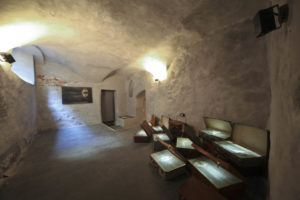 Exhibition view at Guidi&Schoen-Arte Contemporanea Ph. By Francesco Arena
Exhibition view at Guidi&Schoen-Arte Contemporanea Ph. By Francesco Arena
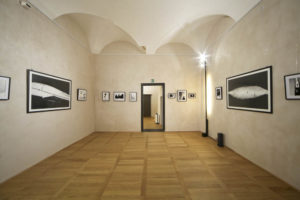 Exhibition view at PRIMO PIANO di Palazzo Grillo Ph. By Francesco Arena
Exhibition view at PRIMO PIANO di Palazzo Grillo Ph. By Francesco Arena
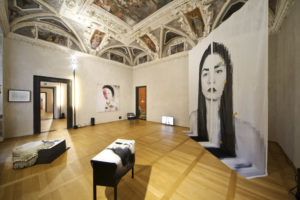 Exhibition view at PRIMO PIANO di Palazzo Grillo Ph. By Francesco Arena
Exhibition view at PRIMO PIANO di Palazzo Grillo Ph. By Francesco Arena
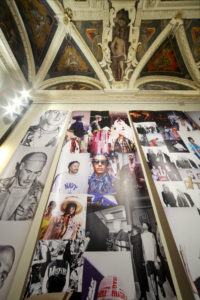 Exhibition view at PRIMO PIANO di Palazzo Grillo Ph. By Francesco Arena
Exhibition view at PRIMO PIANO di Palazzo Grillo Ph. By Francesco Arena
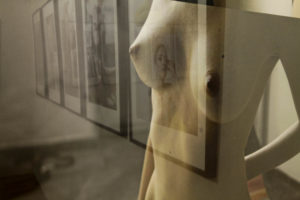 Artwork (detail) by Romolo Giulio Milito. PRIMO PIANO di Palazzo Grillo. Ph. By Francesco Arena
Artwork (detail) by Romolo Giulio Milito. PRIMO PIANO di Palazzo Grillo. Ph. By Francesco Arena
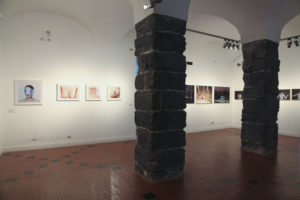 Exhibition view at Sala Dogana-Palazzo Ducale. Ph. By Francesco Arena
Exhibition view at Sala Dogana-Palazzo Ducale. Ph. By Francesco Arena
She graduated at the Academy of Fine Arts in Catania. During her lifetime, she has experienced various arts including sculpture, theatre, dance and photography, and the latter one became the springboard for her eclectic and innovative artistic path. In 2010, she approached the art curatorial world and started to write reviews and critical texts; later, she founded “Artisti Italiani – arti visive e promozione”, an organisation which deals with all the promotional aspects of contemporary art.






NO COMMENT